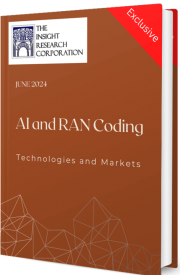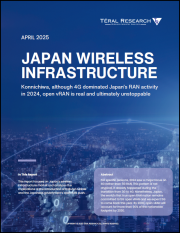
|
시장보고서
상품코드
1499758
세계의 AI 및 RAN 코딩 - 기술과 시장AI and RAN Coding - Technologies and Markets |
||||||
※ 본 상품은 영문 자료로 한글과 영문 목차에 불일치하는 내용이 있을 경우 영문을 우선합니다. 정확한 검토를 위해 영문 목차를 참고해주시기 바랍니다.
이 보고서는 AI 및 RAN 코딩에 대한 조사 분석을 통해 AI가 무선 액세스 네트워크(RAN) 코딩을 변화시키고 네트워크의 효율성과 성능을 향상시키는 방법을 보여줍니다.
목차
제1장 주요 요약
- 주요 견해
- 정량 예측 분류
- 보고서의 구성
제2장 AI/ML/DL의 주요 개념 설명
- AI
- 머신러닝(ML)
- 교사 있음 머신러닝
- 교사 없음 머신러닝
- 강화 머신러닝
- K근방법
- 딥러닝 신경망(DLNN)
- 주목해야 할 ML/DL 알고리즘
- 이상 감지
- 인공 신경망(ANN)
- 가방드 트리즈
- CART, SVM 알고리즘
- 클러스터링
- 조건부 변분 오토엔코더
- CNN
- 상관과 클러스터링
- 진화적 알고리즘과 분산 학습
- 피드 포워드 신경망
- 그래프 신경망
- 하이브리드 인지 엔진(HCE)
- 칼만 필터
- 마르코프 결정 과정
- 다층 퍼셉트론
- 나이브 베이즈
- 방사 기저 함수
- 랜덤 포레스트
- 리커런트 신경망
- 강화 신경망
- SOM 알고리즘
- 스파스 베이지안 학습
제3장 RAN 가상화
- RAN과 그 진화
- E-UTRAN의 상세
- 5G-NR, NSA, SA
- MEC
- 리지드 CPRI
- RAN에서 vRAN으로의 진화
- VM 기반, 컨테이너 기반 vRAN 비교
- NFV 아키텍처
- 컨테이너의 필요성
- 마이크로서비스
- 컨테이너 형태
- 컨테이너 전개 방법
- 스테이트풀 컨테이너, 스테이트리스 컨테이너
- 어드밴티지 컨테이너
- 컨테이너가 직면하는 과제
- RAN 가상화, 얼라이언스의 스토리
- O-RAN 아키텍처 개요
- O-RAN의 역사
- O-RAN의 작업 그룹
- 오픈 vRAN(O-vRAN)
- 통신 인프라 프로젝트(TIP) OpenRAN
제4장 AI 및 RAN 코딩
- O-RAN과 AI
- 소개
- RIC, xApps, rApps
- WG2와 ML
- AI 이용 사례 - 코딩
- 배경
- 방법론과 과제
- AI 기반의 접근
제5장 RAN용 AI에 관한 벤더의 대처
- 소개
- 주목해야 할 고찰
- 기업과 조직의 개요
- Aira Channel Prediction xApp
- Aira Dynamic Radio Network Management rApp
- AirHop Auptim
- Aspire Anomaly Detection rApp
- Cisco Ultra Traffic Optimization
- Capgemini RIC
- Cohere MU-MIMO Scheduler
- DeepSig OmniSig
- Deepsig OmniPHY
- Ericsson Radio System
- Ericsson RIC
- Fujitsu Open RAN Compliant RUs
- HCL iDES rApp
- Huawei PowerStar
- Juniper RIC/Rakuten Symphony Symworld
- Mavenir mMIMO 64TRX
- Mavenir RIC
- Net AI xUPscaler Traffic Predictor xApp
- Nokia RAN Intelligent Controller
- Nokia AVA
- Nokia ReefShark Soc
- Nvidia AI-on-5G platform
- Opanga Networks
- PI Works Intelligent PCI Collision and Confusion Detection rApp
- Qualcomm RIC
- Qualcomm Cellwize CHIME
- Qualcomm Traffic Management Solutions
- Rimedo Policy-controlled Traffic Steering xApp
- Samsung Network Slice Manager
- ZTE PowerPilot
- VMware RIC
제6장 RAN용 AI에 관한 통신 사업자의 대처
- 소개
- 주목해야 할 고찰
- 기업과 조직의 개요
- AT&T Inc
- Axiata Group Berhad
- Bharti Airtel
- China Mobile
- China Telecom
- China Unicom
- CK Hutchison Holdings
- Deutsche Telekom
- Etisalat
- Globe Telecom Inc
- NTT DoCoMo
- MTN Group
- Ooredoo
- Orange
- PLDT Inc
- Rakuten Mobile
- Reliance Jio
- Saudi Telecom Company
- Singtel
- SK Telecom
- Softbank
- Telefonica
- Telenor
- Telkomsel
- T-Mobile US
- Verizon
- Viettel Group
- Vodafone
제7장 정량 분석과 예측
- 조사 방법
- 정량 예측
- 시장 전체
- 휴대폰 통신의 세대
- 지리적 지역
This comprehensive study explores how AI is transforming Radio Access Network (RAN) coding, enhancing network efficiency and performance.
Key highlights:
- AI Integration: Understand how AI is seamlessly integrating into the RAN architecture, particularly through O-RAN initiatives, to optimize coding and improve network adaptability.
- Market Forecasts: Gain insights into market trends and forecasts for AI-driven RAN coding technologies, segmented by mobile telephony generations and geographical regions.
- Vendor and Telco Initiatives: Discover the innovative AI solutions from leading vendors and the strategic initiatives by telecom operators to leverage AI in RAN coding.
This report offers valuable insights for network planners, vendors, and telecom operators looking to stay ahead in the evolving landscape of AI and RAN coding. Get your copy today and lead the way in network innovation.
Highlights
- Insight Research breaks down the market for AI in RAN coding two criteria- mobility generation and geographical regions.
- Insight Research considers two mobility generations- 5G and others; and four geographical regions- NA, EMEA, APAC and CALA.
Table of Contents
1. Executive Summary
- 1.1. Key observations
- 1.2. Quantitative Forecast Taxonomy
- 1.3. Report Organization
2. AI/ML/DL Key Concepts Explainer
- 2.1. Artificial Intelligence
- 2.2. Machine Learning (ML)
- 2.2.1. Supervised Machine Learning
- 2.2.2. Unsupervised Machine Learning
- 2.2.3. Reinforced Machine Learning
- 2.2.4. K-Nearest Neighbor
- 2.3. Deep Learning Neural Network (DLNN)
- 2.4. Noteworthy ML and DL Algorithms
- 2.4.1. Anomaly Detection
- 2.4.2. Artificial Neural Networks (ANN)
- 2.4.3. Bagged Trees
- 2.4.4. CART and SVM Algorithms
- 2.4.5. Clustering
- 2.4.6. Conditional Variational Autoencoder
- 2.4.7. Convolutional Neural Network
- 2.4.8. Correlation and Clustering
- 2.4.9. Evolutionary Algorithms and Distributed Learning
- 2.4.10. Feed Forward Neural Network
- 2.4.11. Graph Neural Networks
- 2.4.12. Hybrid Cognitive Engine (HCE)
- 2.4.13. Kalman Filter
- 2.4.14. Markov Decision Processes
- 2.4.15. Multilayer Perceptron
- 2.4.16. Naive Bayes
- 2.4.17. Radial Basis Function
- 2.4.18. Random Forest
- 2.4.19. Recurrent Neural Network
- 2.4.20. Reinforced Neural Network
- 2.4.21. SOM Algorithm
- 2.4.22. Sparse Bayesian Learning
3. Virtualization of the RAN
- 3.1. The RAN and its Evolution
- 3.1.1. Closer Look at E-UTRAN
- 3.1.2. 5G- NR, NSA and SA
- 3.1.3. MEC
- 3.1.4. The Rigid CPRI
- 3.2. The Progression of the RAN to the vRAN
- 3.3. How VM-based and Container-based vRANs Compare?
- 3.3.1. NFV architecture
- 3.3.2. The Need for Containers
- 3.3.3. Microservices
- 3.3.4. Container Morphology
- 3.3.5. Container Deployment Methodologies
- 3.3.6. Stateful and Stateless Containers
- 3.3.7. Advantage Containers
- 3.3.8. Challenges Confronting Containers
- 3.4. RAN Virtualization A Story of Alliances
- 3.4.1. O-RAN Architecture Overview
- 3.4.2. History of O-RAN
- 3.4.3. Workgroups of O-RAN
- 3.4.4. Open vRAN (O-vRAN)
- 3.4.5. Telecom Infra Project (TIP) OpenRAN
4. AI and RAN Coding
- 4.1. O-RAN and AI
- 4.1.1. Introduction
- 4.1.2. RIC, xApps and rApps
- 4.1.3. WG2 and ML
- 4.2. AI Use-Case - Coding
- 4.2.1. Background
- 4.2.2. Methodologies and Challenges
- 4.2.3. AI-based Approaches
5. Vendor Initiatives for AI in the RAN
- 5.1. Introduction
- 5.2. Salient Observations
- 5.3. Company and Organization Summary
- 5.4. Aira Channel Prediction xApp
- 5.5. Aira Dynamic Radio Network Management rApp
- 5.6. AirHop Auptim
- 5.7. Aspire Anomaly Detection rApp
- 5.8. Cisco Ultra Traffic Optimization
- 5.9. Capgemini RIC
- 5.10. Cohere MU-MIMO Scheduler
- 5.11. DeepSig OmniSig
- 5.12. Deepsig OmniPHY
- 5.13. Ericsson Radio System
- 5.14. Ericsson RIC
- 5.15. Fujitsu Open RAN Compliant RUs
- 5.16. HCL iDES rApp
- 5.17. Huawei PowerStar
- 5.18. Juniper RIC/Rakuten Symphony Symworld
- 5.19. Mavenir mMIMO 64TRX
- 5.20. Mavenir RIC
- 5.21. Net AI xUPscaler Traffic Predictor xApp
- 5.22. Nokia RAN Intelligent Controller
- 5.23. Nokia AVA
- 5.24. Nokia ReefShark Soc
- 5.25. Nvidia AI-on-5G platform
- 5.26. Opanga Networks
- 5.27. P.I. Works Intelligent PCI Collision and Confusion Detection rApp
- 5.28. Qualcomm RIC
- 5.29. Qualcomm Cellwize CHIME
- 5.30. Qualcomm Traffic Management Solutions
- 5.31. Rimedo Policy-controlled Traffic Steering xApp
- 5.32. Samsung Network Slice Manager
- 5.33. ZTE PowerPilot
- 5.34. VMware RIC
6. Telco Initiatives for AI in the RAN
- 6.1. Introduction
- 6.2. Salient Observations
- 6.3. Company and Organization Summary
- 6.4. AT&T Inc
- 6.5. Axiata Group Berhad
- 6.6. Bharti Airtel
- 6.7. China Mobile
- 6.8. China Telecom
- 6.9. China Unicom
- 6.10. CK Hutchison Holdings
- 6.11. Deutsche Telekom
- 6.12. Etisalat
- 6.13. Globe Telecom Inc
- 6.14. NTT DoCoMo
- 6.15. MTN Group
- 6.16. Ooredoo
- 6.17. Orange
- 6.18. PLDT Inc
- 6.19. Rakuten Mobile
- 6.20. Reliance Jio
- 6.21. Saudi Telecom Company
- 6.22. Singtel
- 6.23. SK Telecom
- 6.24. Softbank
- 6.25. Telefonica
- 6.26. Telenor
- 6.27. Telkomsel
- 6.28. T-Mobile US
- 6.29. Verizon
- 6.30. Viettel Group
- 6.31. Vodafone
7. Quantitative Analysis and Forecasts
- 7.1. Research Methodology
- 7.2. Quantitative Forecasts
- 7.2.1. Overall Market
- 7.2.2. Mobile Telephony Generations
- 7.2.3. Geographical Regions
Tables and Figures
- Figure 3-1: VNF versus CNF Stacks
- Figure 3-2: O-RAN High-Level Architecture
- Figure 3-3: O-RAN High-Level Architecture
- Figure 3-4: Architecture of vRAN Base Station as Visualized by TIP
- Figure 4-1: Reinforcement learning model training and actor locations per O-RAN WG2
- Figure 4-2: AI/ML Workflow in the O-RAN RIC as proposed O-RAN WG2
- Figure 4-3: AI/ML deployment scenarios
- Table 5-1: AI in RAN Product and Solution Vendor Summary
- Figure 5-1: The Aira channel detection xApp functional blocks
- Figure 5-2: Modules of the Aspire Anomaly Detection rApp
- Figure 5-3: OmniPHY Module Drop in Typical vRAN Stack Overview
- Figure 5-4: Ericsson IAP
- Figure 5-5: HCL iDES rApp Architecture
- Figure 5-6: Working of the Net Ai xUPscaler
- Figure 5-7: Nokia RIC programmability via AI/ML and Customized Applications
- Figure 5-8: Timesharing the GPU in Nvidia Aerial A100
- Figure 5-8: Rimedo TS xApp in the O-RAN architecture
- Figure 5-9: Rimedo TS xApp in the VMware RIC
- Figure 5-10: PowerPilot Solution Evolution
- Table 6-1: AI in RAN Telco Profile Snapshot
- Table 7-1: Addressable Market in Coding End-Application in Mobile RAN for AI and Related Technologies 2023-2028 ($ million)
- Table 7-2: Addressable Market in Coding End-Application in Mobile RAN for AI and Related Technologies; by Mobile Telephony Generation 2023-2028 ($ million)
- Figure 7-1: Share of Addressable Market in Coding End-Application in Mobile RAN for AI and Related Technologies; by Mobile Telephony Generation 2023-2028
- Table 7-3: Addressable Market in Coding End-Application in Mobile RAN for AI and Related Technologies; by Geographical Region 2023-2028 ($ million)
- Figure 7-2: Share of Addressable Market in Coding End-Application in Mobile RAN for AI and Related Technologies; by Geographical egion 2023-2028
샘플 요청 목록



















